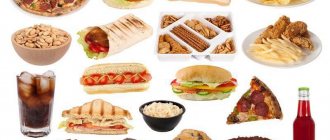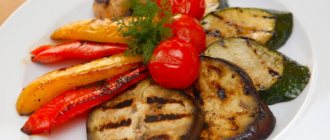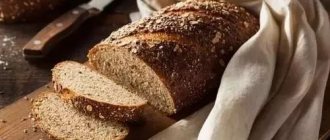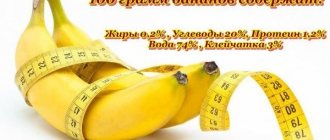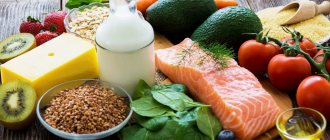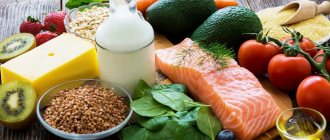General rules
purines in the body consists of two sources of their supply - endogenous (internal) synthesis and intake from food.
Purine metabolism is a chain of complex biochemical reactions involving various enzyme systems. During the process of metabolism of purine nucleotides, the end product is uric acid , which is excreted from the body by the kidneys. However, when purine metabolism is disrupted, uric acid is not excreted to physiologically normal levels and a state of hyperuricemia (increased levels of uric acid in the blood) occurs.
When a certain concentration of uric acid is reached, crystals begin to form, which are subsequently deposited in the synovium of the joints, kidneys and under the skin, causing diseases such as gout , urolithiasis , cystinuria , uric acid diathesis , oxaluria . Violation of purine metabolism in most cases is also accompanied by a violation of lipid metabolism.
In order to reduce the intake of purines from food, a low-purine diet . This diet includes Table No. 6 , the purpose of which is to normalize the processes of purine metabolism, reduce the level of uric acid and its salts and correct the urine reaction in the alkaline direction. Alkalinization of urine increases the solubility of urates , which accelerates the removal of uric acid from the body and disrupts the process of their formation.
The hypopurine diet involves limiting the diet of foods that contain large amounts of purines, as well as oxalic acid, while limiting the intake to 10 g/day of sodium chloride. At the same time, the diet is expanded to include foods that have an alkalizing effect (milk, vegetables/fruits). The content of purines in food varies widely and a special table gives an idea of their amount.
| Product name | Approximate purine content (mg/100 g of product) |
| Sardines | 125 |
| Beef liver | 300 |
| Sprats | 87 |
| Beef | 80-100 |
| Chicken | 110 |
| Veal | 150 |
| Herring | 128 |
| Peas | 105 |
| Soybeans | 90 |
| Salmon | 100 |
| Dry yeast | 750 |
| Beans | 75 |
| Rabbit | 65 |
| Mussels | 150 |
| Wholemeal bread | 24 |
| Beef tongue | 72 |
| Trout | 85 |
The table of purines in food allows the patient to navigate the choice of foods for his diet. However, not all purine bases are broken down into uric acid, and risk factors include only those purines that, as a result of cleavage, are converted into uric acid in the body. These include purine compounds such as guanine , adenine , hypoxanthine , xanthine .
Other purine compounds - caffeine , theophylline and theobromine , found in cocoa, coffee, tea and chocolate, are not dangerous. The maximum amount of purine bases is found in meat and animal by-products that are actively involved in metabolism: liver, calf thymus, kidneys and products with rapidly dividing cells (yeast, cereal sprouts, asparagus, young greens).
The energy value of the dietary table is 2700-3000 kcal with a restriction in the diet of proteins to 70-80 g and up to 80-90 g of fats (mainly due to refractory ones). Carbohydrate consumption is at a level of 400 g (in the absence of obesity ). The volume of free liquid is 2 liters or more. Small meals up to 5-6 times a day with plenty of drink on an empty stomach and in between meals.
There are no special requirements for the culinary processing of products, with the exception of meat, which, before further processing, is cooked with preliminary short-term (5-10 minutes) boiling and draining of the first broth. In the menu outside the period of exacerbation, meat/fish dishes can be present no more than 2-3 times a week, and their weight should not exceed 150-170 g per day
The antipurine diet provides fasting days with a frequency of once a week (curd-kefir in the form of 1 liter of kefir and 400 g of low-fat cottage cheese or fruit - with the consumption of up to 1.5 kg of vegetables/fruits) with an increase in the volume of free liquid on such days to 2, 5-3 liters.
Fasting days are especially important during an exacerbation period and during this period they are carried out every other day. Thus, a purine diet for gout during an exacerbation involves excluding any type of meat and fish from the diet by increasing the consumption of fermented milk products, soups based on vegetables and milk, herbal teas and fruit infusions.
Why is a diet necessary for high uric acid?
Purines are consumed in food and are essential for the body. They are part of the chromosomes in the cell nucleus. They carry genetic information.
When purines break down, is formed .
Uric acid is excreted in the urine by the kidneys.
When eating foods rich in purines, uric acid may accumulate and not have time to be eliminated.
An excess of uric acid in the blood makes it difficult for oxygen to penetrate the cells. Salts are deposited in the kidneys, joints and other tissues.
It turns out that less oxygen means more uric acid, more uric acid means less oxygen enters the tissues. Fatigue, bad mood, loss of energy, joint pain - all these are possible symptoms of an excess of purines . This means that it is necessary to limit purines during meals. Hence the name - antipurine diet .
Varieties
In the presence of obesity, patients are prescribed a purine-free diet - dietary Table 6E . It is characterized by a lower energy value of the diet (1950-2000 Kcal), protein content is reduced to 70 g, fat - to 80 g, and carbohydrate intake - to 250 g, mainly due to simple carbohydrates (fresh wheat bread, sugar, honey, confectionery /flour products, sweets).
The consumption of meat in the diet is limited to 1-2 times a week, drinking plenty of water, alkaline mineral water is especially recommended. The diet is not complete and can be prescribed to patients for a short period of time (up to two weeks).
Authorized Products
The diet should contain many different vegetables: eggplants, white cabbage, carrots, tomatoes, zucchini, cucumbers, potatoes. White and black bread are allowed. It is important to include fruits and various berries in your diet - pears, plums, apples, apricots, oranges. Turkey, rabbit, and chicken are allowed. You can eat chicken eggs and boiled fish. Fermented milk products, low-fat cottage cheese and dishes made from it, low-fat cheeses, and milk are required in the diet.
Pasta and various cereals cooked with diluted milk are recommended. It is important to include vegetable oils (linseed and olive) in your diet. Among sweets, marshmallows are allowed, not chocolate candies, jam, marmalade, marshmallows.
Drink - green tea, vegetable juices, compotes and fruit drinks, decoctions of chicory, rose hips, wheat bran, fruits, berries, kvass. The diet should include slightly mineralized non-carbonated alkaline mineral waters, cucumber juice, and lingonberry juice.
Table of permitted products
| Proteins, g | Fats, g | Carbohydrates, g | Calories, kcal | |
Vegetables and greens | ||||
| zucchini | 0,6 | 0,3 | 4,6 | 24 |
| potato | 2,0 | 0,4 | 18,1 | 80 |
| carrot | 1,3 | 0,1 | 6,9 | 32 |
| tomatoes | 0,6 | 0,2 | 4,2 | 20 |
Fruits | ||||
| apricots | 0,9 | 0,1 | 10,8 | 41 |
| oranges | 0,9 | 0,2 | 8,1 | 36 |
| pears | 0,4 | 0,3 | 10,9 | 42 |
| plums | 0,8 | 0,3 | 9,6 | 42 |
| apples | 0,4 | 0,4 | 9,8 | 47 |
Nuts and dried fruits | ||||
| prunes | 2,3 | 0,7 | 57,5 | 231 |
Bakery products | ||||
| wheat bread | 8,1 | 1,0 | 48,8 | 242 |
| bran bread | 7,5 | 1,3 | 45,2 | 227 |
Confectionery | ||||
| jam | 0,3 | 0,2 | 63,0 | 263 |
| marshmallows | 0,8 | 0,0 | 78,5 | 304 |
| paste | 0,5 | 0,0 | 80,8 | 310 |
Raw materials and seasonings | ||||
| honey | 0,8 | 0,0 | 81,5 | 329 |
Dairy | ||||
| milk | 3,2 | 3,6 | 4,8 | 64 |
| kefir 2.5% | 2,8 | 2,5 | 3,9 | 50 |
| Ryazhenka 2.5% | 2,9 | 2,5 | 4,2 | 54 |
| curdled milk | 2,9 | 2,5 | 4,1 | 53 |
| acidophilus | 2,8 | 3,2 | 3,8 | 57 |
| yogurt | 4,3 | 2,0 | 6,2 | 60 |
Cheeses and cottage cheese | ||||
| sulguni cheese | 20,0 | 24,0 | 0,0 | 290 |
| cottage cheese 0.6% (low fat) | 18,0 | 0,6 | 1,8 | 88 |
Meat products | ||||
| rabbit | 21,0 | 8,0 | 0,0 | 156 |
Bird | ||||
| chicken | 16,0 | 14,0 | 0,0 | 190 |
| turkey | 19,2 | 0,7 | 0,0 | 84 |
Eggs | ||||
| chicken eggs | 12,7 | 10,9 | 0,7 | 157 |
Oils and fats | ||||
| butter | 0,5 | 82,5 | 0,8 | 748 |
| linseed oil | 0,0 | 99,8 | 0,0 | 898 |
| olive oil | 0,0 | 99,8 | 0,0 | 898 |
Non-alcoholic drinks | ||||
| green tea | 0,0 | 0,0 | 0,0 | — |
Juices and compotes | ||||
| cucumber juice | 0,8 | 0,1 | 2,5 | 14 |
| tomato juice | 1,1 | 0,2 | 3,8 | 21 |
| Apple juice | 0,4 | 0,4 | 9,8 | 42 |
| * data is per 100 g of product | ||||
List of products for table No. 6
To stop the formation of crystals from uric acid, you need to include alkaline food in table number 6:
- vegetables and fruits (fresh, cooked and pickled in large quantities);
- roots;
- bread from any flour (only 2nd grade);
- boiled and baked meat (150 g per day);
- lean fish (170 g per day);
- quail or chicken eggs (1-2 pieces per day);
- any cereals (except for dried unrefined cereals);
- prunes;
- fermented milk products, milk, cottage cheese;
- citruses;
- nuts;
- marmalade, pastille, honey, jam, jam;
- alkaline waters, chicory, green tea;
- herbal decoctions.
It is necessary to exclude from the menu foods containing purines:
- mushroom broths, meat soups, fish soup;
- fish caviar;
- fatty meat and poultry, offal;
- spinach and sorrel;
- mushrooms in any form;
- peas, soybeans, beans (except green beans), legumes;
- rich and sweet pastries;
- salted cheese;
- margarine (pure or in dishes);
- any smoked meats;
- raspberries, cranberries, viburnum, rhubarb, figs;
- spicy and highly salty: sauces, spices, herbs;
- alcoholic drinks.
It’s better to print out the grocery list or write it on a piece of paper to make it easier to follow all the diet rules at first. Making a daily diet from the proposed permitted foods is not as difficult as it might seem: you can have a first meal, meat with a side dish, cutlets, casseroles, homemade dumplings and dumplings, and much more. For a visual example, consider the menu for the week and some dietary recipes.
Fully or partially limited products
The low-purine diet excludes the consumption of red meat and all types of offal (kidneys, liver, heart), salted, fatty and fried fish, seafood (shrimp, shellfish), caviar, canned fish, and all smoked meats. Pork, beef and cooking fats are limited. Foods rich in plant proteins (beans, beans, lentils, peas, soybeans), and various spices (pepper, horseradish, mustard) are excluded from the diet. It is prohibited to consume chocolate, sharp cheeses, cream cakes, pastries, as well as some berries - cranberries, grapes, figs, raspberries.
The consumption of carbohydrates in the form of bread, porridge with meat broth is limited. It is undesirable to introduce cauliflower, peppers, mushrooms, spinach, sorrel, rhubarb, asparagus, radishes, and celery into the diet. Despite the fact that purines contained in black tea, coffee, and cocoa are not broken down, their limitation is justified because, having a diuretic effect, they dehydrate the cell, thereby increasing the concentration of uric acid. Limit salt consumption. Drinking alcohol-containing drinks, especially red wines, beer and cognac, is absolutely unacceptable.
Table of prohibited products
| Proteins, g | Fats, g | Carbohydrates, g | Calories, kcal | |
Vegetables and greens | ||||
| beans | 6,0 | 0,1 | 8,5 | 57 |
| peas | 6,0 | 0,0 | 9,0 | 60 |
| chickpeas | 19,0 | 6,0 | 61,0 | 364 |
| soybeans | 34,9 | 17,3 | 17,3 | 381 |
| beans | 7,8 | 0,5 | 21,5 | 123 |
| horseradish | 3,2 | 0,4 | 10,5 | 56 |
| lentils | 24,0 | 1,5 | 42,7 | 284 |
| sorrel | 1,5 | 0,3 | 2,9 | 19 |
Fruits | ||||
| figs | 0,7 | 0,2 | 13,7 | 49 |
Berries | ||||
| cranberry | 0,5 | 0,0 | 6,8 | 26 |
| raspberries | 0,8 | 0,5 | 8,3 | 46 |
Mushrooms | ||||
| mushrooms | 3,5 | 2,0 | 2,5 | 30 |
Chocolate | ||||
| chocolate | 5,4 | 35,3 | 56,5 | 544 |
Raw materials and seasonings | ||||
| mustard | 5,7 | 6,4 | 22,0 | 162 |
| mayonnaise | 2,4 | 67,0 | 3,9 | 627 |
Meat products | ||||
| pork | 16,0 | 21,6 | 0,0 | 259 |
| pork liver | 18,8 | 3,6 | 0,0 | 108 |
| pork kidneys | 13,0 | 3,1 | 0,0 | 80 |
| salo | 2,4 | 89,0 | 0,0 | 797 |
| beef | 18,9 | 19,4 | 0,0 | 187 |
| beef liver | 17,4 | 3,1 | 0,0 | 98 |
| beef brains | 9,5 | 9,5 | 0,0 | 124 |
| mutton | 15,6 | 16,3 | 0,0 | 209 |
| bacon | 23,0 | 45,0 | 0,0 | 500 |
Sausages | ||||
| smoked sausage | 28,2 | 27,5 | 0,0 | 360 |
Fish and seafood | ||||
| pink salmon | 20,5 | 6,5 | 0,0 | 142 |
| Red caviar | 32,0 | 15,0 | 0,0 | 263 |
| squid | 21,2 | 2,8 | 2,0 | 122 |
| shrimps | 22,0 | 1,0 | 0,0 | 97 |
| salmon | 19,8 | 6,3 | 0,0 | 142 |
| mussels | 9,1 | 1,5 | 0,0 | 50 |
| herring | 16,3 | 10,7 | — | 161 |
| salmon | 21,6 | 6,0 | — | 140 |
| mackerel | 18,0 | 13,2 | 0,0 | 191 |
Oils and fats | ||||
| animal fat | 0,0 | 99,7 | 0,0 | 897 |
| cooking fat | 0,0 | 99,7 | 0,0 | 897 |
Alcoholic drinks | ||||
| red dessert wine | 0,5 | 0,0 | 20,0 | 172 |
| vodka | 0,0 | 0,0 | 0,1 | 235 |
| cognac | 0,0 | 0,0 | 0,1 | 239 |
| liquor | 0,3 | 1,1 | 17,2 | 242 |
| beer | 0,3 | 0,0 | 4,6 | 42 |
Non-alcoholic drinks | ||||
| coffee | 0,2 | 0,0 | 0,3 | 2 |
| black tea | 20,0 | 5,1 | 6,9 | 152 |
| * data is per 100 g of product | ||||
Basic principles of diet for gout
Gout is characterized by the accumulation of uric acid salt crystals in the joints and kidneys. They irritate their structures, provoking the development of severe inflammation. In order for the crystals to dissolve and be evacuated from the body naturally, an alkaline environment is required. That is, you should eat foods that, after breaking down, would increase the pH to 6-8. At the same time, it is necessary to limit the intake of purines. It is due to a violation of the regulation of their metabolism in the body that the concentration of uric acid increases.
After the diagnosis is made, the patient is referred to a nutritionist. He develops an approximate menu taking into account the severity of gout, the degree of damage to the joints and (or) kidneys. The doctor must give recommendations regarding diet:
- you need to eat often (5-7 times a day), but in small portions;
- Food should be baked, simmered in a small amount of water, steamed;
- in the absence of contraindications, you must drink at least 2.5 liters of liquid.
In the vast majority of cases, the impetus for the development of gout was the consumption of fatty foods in combination with alcohol. It is not surprising that it is predominantly overweight men who suffer from it. Nutritionists advise them to limit the energy consumption of the daily menu to 2000-2500 kilocalories. This will help you lose weight, reduce the load on sore joints, and improve your overall health.
Low purine diet menu
The low-purine diet menu for a week includes the maximum number of permitted foods, taking into account the permitted methods of culinary processing, which allows you to diversify the patient’s diet.
Monday
| Breakfast |
|
| Lunch |
|
| Dinner |
|
| Dinner |
|
| For the night |
|
Tuesday
| Breakfast |
|
| Lunch |
|
| Dinner |
|
| Dinner |
|
| For the night |
|
Wednesday
| Breakfast |
|
| Lunch |
|
| Dinner |
|
| Dinner |
|
| For the night |
|
Thursday
| Breakfast |
|
| Lunch |
|
| Dinner |
|
| Dinner |
|
| For the night |
|
Friday
| Breakfast |
|
| Lunch |
|
| Dinner |
|
| Dinner |
|
| For the night |
|
Saturday
| Breakfast |
|
| Lunch |
|
| Dinner |
|
| Dinner |
|
| For the night |
|
Sunday
| Breakfast |
|
| Lunch |
|
| Dinner |
|
| Dinner |
|
| For the night |
|
Reviews and results
Most patient reviews indicate that a low-purine diet is quite effective for disorders of purine metabolism and allows it to be normalized relatively quickly.
- “... Having had gout for a long time, at the first sign of an exacerbation I immediately go on a vegetarian diet with 2-3 fasting days on vegetables or kefir, and then I switch to Diet 6, at the same time, I increase my physical activity - I work out in the gym”;
- “... I have been following a strict anti-purine diet for almost 7 years. In combination with taking anti-gout medications, I achieved good results. I have had no seizures for 4 years now, and it has become much easier for me to move around”;
- “... I am almost 60 years old and have had gout with frequent attacks for almost 10 years. The pain is very strong, I can’t leave the house, I move around the house on crutches. I relieve the pain with pills and go on a diet with vegetables. Usually after 2 weeks the pain goes away and I can lead my normal life.”

